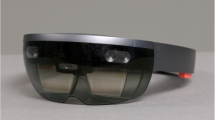Abstract
Augmented Reality (AR) has a high potential to help healthcare professionals in the operating room and researchers have been working on bringing AR to the operating room for many different types of surgeries so far. However, there are thousands of surgery types that might benefit from the AR. Our goal is to identify which surgeries could benefit the most from AR and identify the common functionality desired in an AR app for surgery and then come up with a unified user interface (UI) design for these surgeries. To achieve this goal, we analyzed the historical number of surgeries performed at a teaching and research hospital to find the most frequently performed surgeries. Starting with the most frequently performed surgeries, we collaborated with the experienced surgeons to find out the surgeries that could benefit from AR the most. For each surgery, we identified the functionality and the information that could be presented on an AR app before, during and after surgery. We prepared the list of surgeries that might benefit from AR through a series of thorough interviews with experienced surgeons. We also identified the functionalities desired in AR apps for surgery and prepared a unified UI design for the common functionality.
We believe that the unified UI that we designed for the AR App of surgical procedures is the first step towards an AR app that might be beneficial for many types of surgeries. We believe surgeons equipped with AR apps will achieve better results; the success rates of surgical procedures will increase while the number of errors decreases.
Access this chapter
Tax calculation will be finalised at checkout
Purchases are for personal use only
Similar content being viewed by others
References
Furht, B.: Handbook of Augmented Reality. Springer, New York (2011). https://doi.org/10.1007/978-1-4614-0064-6
McMains, V.: Study Suggests Medical Errors Now Third Leading Cause of Death in the U.S. https://www.hopkinsmedicine.org. Short url https://bit.ly/2iOcECc. Accessed 14 Feb 2019
Zhou, F., Dun, H.B.L., Billinghurst, M.: Trends in augmented reality tracking, interaction and display: a review of ten years of ISMAR. In: Proceedings - 7th IEEE International Symposium on Mixed and Augmented Reality, ISMAR, pp. 193–202 (2008)
Behringer, R., Christian, J., Holzinger, A., Wilkinson, S.: Some usability issues of augmented and mixed reality for e-health applications in the medical domain. In: Holzinger, A. (ed.) USAB 2007. LNCS, vol. 4799, pp. 255–266. Springer, Heidelberg (2007). https://doi.org/10.1007/978-3-540-76805-0_21
Livingston, M.A.: Issues in human factors evaluations of augmented reality systems. In: Huang, W., Alem, L., Livingston, M. (eds.) Human Factors in Augmented Reality Environment, pp. 3–9. Springer, New York (2013). https://doi.org/10.1007/978-1-4614-4205-9_1
Ma, M., Jain, L.C., Anderson, P.: Virtual, Augmented Reality and Serious Games for Healthcare 1. Springer, Heidelberg (2014). https://doi.org/10.1007/978-3-642-54816-1
Ganapathy, S.: Design guidelines for mobile augmented reality: user experience. In: Huang, W., Alem, L., Livingston, M. (eds.) Human Factors in Augmented Reality Environments, pp. 165–180. Springer, New York (2013). https://doi.org/10.1007/978-1-4614-4205-9_7
Huang, W., Alem, L., Livingston, M.A.: Human Factors in Augmented Reality Environments. Springer, New York (2013). https://doi.org/10.1007/978-1-4614-4205-9
Gabbard, J.L., Swan, J.E.: Usability engineering for augmented reality: employing user-based studies to inform design. IEEE Trans. Vis. Comput. Graph. 14(3), 513–525 (2008)
Kalkofen, D., et al.: Integrated medical workflow for augmented reality applications. In: International Workshop on Augmented Environments for Medical Imaging and Computer-Aided Surgery (AMI-ARCS), Copenhagen (2006)
Celikoyar, M.M., Aslan, C.G., Cinar, F.: An effective method for video recording the nasal–dorsal part of a rhinoplasty – a multiple case study. J. Vis. Commun. Med. 39(3–4), 112–119 (2016)
Acknowledgements
We would like to thank the following doctors and surgeons for their time and input in this research; Dr. Cem Heper, Dr. Murat Öztürk, Prof. Dr. Mehmet Aral Atalay, Prof. Dr. Mehmet Baykara, Prof. Dr. Şeref Doğan, Prof. Dr. Hasan Kocaeli, Prof. Dr. Ersin Öztürk, Dr. Deniz Tihan, Prof. Dr. Sadık Kılıçturgay, Prof. Dr. Burak Demirağ, Assoc. Prof. Dr. Burak Akesen, Prof. Dr. Serhat Özbek. This research was initially funded by TUBITAK (The Scientific and Technological Research Council of Turkey).
Author information
Authors and Affiliations
Corresponding author
Editor information
Editors and Affiliations
Rights and permissions
Copyright information
© 2019 Springer Nature Switzerland AG
About this paper
Cite this paper
Topsakal, O., Mazhar Çelikoyar, M. (2019). Surgeries That Would Benefit from Augmented Reality and Their Unified User Interface. In: De Paolis, L., Bourdot, P. (eds) Augmented Reality, Virtual Reality, and Computer Graphics. AVR 2019. Lecture Notes in Computer Science(), vol 11613. Springer, Cham. https://doi.org/10.1007/978-3-030-25965-5_22
Download citation
DOI: https://doi.org/10.1007/978-3-030-25965-5_22
Published:
Publisher Name: Springer, Cham
Print ISBN: 978-3-030-25964-8
Online ISBN: 978-3-030-25965-5
eBook Packages: Computer ScienceComputer Science (R0)




